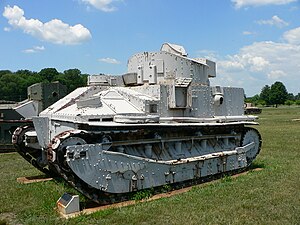| Vickers Medium Mark II | |
|---|---|
 Vickers Medium Mk.IIA* at U.S. Army Ordnance Museum, Aberdeen | |
| Type | Medium tank |
| Place of origin | UK |
| Service history | |
| In service | 1925–1939 |
| Production history | |
| Manufacturer | Vickers |
| Produced | 1925–1934 (including reworking) |
| Specifications | |
| Mass | 12.2 long tons (12.4 t)[1] |
| Length | 17 feet 6 inches (5.33 m)[1] |
| Width | 9 feet 3 inches (2.82 m)[1] |
| Height | 8 feet 10 inches (2.69 m)[1] |
| Crew | 5 |
| Armour | 0.25 inches (6.35 mm) to 0.315 inches (8.0 mm)[1] |
Main armament | QF 3-pounder (47 mm) |
Secondary armament | 4 × 0.303 (7.7 mm) Hotchkiss M1909 Benét–Mercié machine gun 2 × 0.303 Vickers machine gun |
| Engine | Armstrong Siddeley V-8 90 horsepower (67 kW)[1] |
| Power/weight | 8 hp/tonne |
| Suspension | helical springs |
Operational range | 193 km |
| Maximum speed | 15.6 mph (25.1 km/h)[1] |
The Vickers Medium Mark II was a British medium tank built by Vickers during the interwar period of the First and Second World Wars.
The Medium Mark II, derived from the Vickers Medium Mark I, was developed to replace the last of the Medium Mark Cs still in use. Production and rebuilding ran from 1925 until 1934. The tank was phased out of service from 1939, replaced by the Cruiser Mk I. It featured several improvements over the Vickers Mark I: a higher superstructure with the driver's visor on top of it instead of in front of it; an improved suspension protected by armour skirts; and Rackham clutches, providing a primitive form of mechanical servo-control. Due to a slightly higher weight its rated speed was somewhat slower than that of the Medium Mark I, at 13 mph (21 km/h) compared to 15 mph (24 km/h).